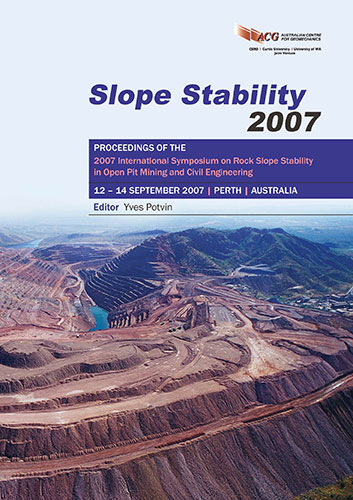Pit Slope Design in Pilbara Iron Deposits - Deposit A West Angelas, Western Australia

|
Authors: Eggers, MJ; Casparis, DL |
DOI https://doi.org/10.36487/ACG_repo/708_31
Cite As:
Eggers, MJ & Casparis, DL 2007, 'Pit Slope Design in Pilbara Iron Deposits - Deposit A West Angelas, Western Australia', in Y Potvin (ed.), Slope Stability 2007: Proceedings of the 2007 International Symposium on Rock Slope Stability in Open Pit Mining and Civil Engineering, Australian Centre for Geomechanics, Perth, pp. 463-476, https://doi.org/10.36487/ACG_repo/708_31
Abstract:
The Deposit A pit design at West Angelas, Western Australia is characterised by a long, narrow shape which will ultimately be some six kilometres in length and up to 200 metres deep. This paper summarises geotechnical investigations undertaken to date for pit slope design, describes the notable elements of the structural and rock mass models that characterise the deposit and discusses their impacts on slope stability and design. The deposit comprises three primary synclines which are asymmetrical in shape, north-verging and open to isoclinal in attitude. The southern limbs are short, steeply dipping to overturned and contain tight second- order parasitic folds while the northern limbs are longer, planar and moderately dipping. Thrust faults are interpreted in some areas of the southern limbs to accommodate a repetition in sequence although there is some evidence this may also be due to recumbent folding. A major objective of the geotechnical studies was to investigate any differences in structural and rock mass conditions between the northern and southern limbs of the primary synclines. Several controls were investigated including lithostratigraphy, weathering and alteration related to near-surface and mineralisation effects and structural controls such as folding and faulting. A “halo” of oxidised and altered Banded Iron Formation (BIF) surrounds the mineralised zone, while there are some differences between the relatively clay-rich and clay-poor zones of the BIF units. The main influence on slope stability and design is structure, in particular planar sliding along low strength shale bands where bedding dips out of the slope. The key elements are the position, shape, orientation and condition of the shale bands controlled by lithostratigraphy and folding. Rock mass failure and combination structure and rock mass mechanisms also require checking, especially within the poorer altered BIF rock mass adjacent to the mineralised zone.
References:
Blockley, J.G., Tehnas, I.J., Mandyczewsky, A. and Morris, R.C. (1993) Proposed stratigraphic subdivisions of the
Marra Mamba Iron Formation and the lower Wittenoom Dolomite, Hamersley Group, Western Australia.
Geological Survey of Western Australia, Professional Papers Report 34.
Duncan, A.C. (1997) Structural Geology Interpretation of the West Angelas A and B Deposits, Robe Resource
Development Department Report 1152, February 1997, 38 p.
Eggers, M.J. (2003a) West Angelas Deposit A – Status of Geotechnical Model for Final Pit Slope Design, Pells
Sullivan Meynink Pty Ltd report PSM601.R1 to Robe River Mining Co Pty Ltd, June 2003.
Eggers, M.J. (2003b) West Angelas Deposit A – Review of Geological Sections and Planning for Proposed
Geotechnical Drilling, Pells Sullivan Meynink Pty Ltd memorandum PSM601.M1 to Robe River Mining Co Pty
Ltd, October 2003.
Eggers, M.J. (2004) West Angelas Deposit A – WEP2 and EAP3 slope designs, Pells Sullivan Meynink Pty Ltd report
PSM601.R3 to Robe River Mining Co Pty Ltd, 18 November 2004, 29 p.
Eggers, M.J. and Coleman, H. (2004) West Angelas operations Deposit A geotechnical investigations 2004. Pells
Sullivan Meynink Pty Ltd report PSM601.R2 to Robe River Mining Co. Pty Ltd, 17 September 2004, 42 p.
Eggers, M.J. (2006) West Angelas beyond 25Mtpa feasibility study – geotechnical summary, Pells Sullivan Meynink
Pty Ltd report PSM601.R4 to Rio Tinto Iron Ore, 6 February 2006, 27 p.
Hencher, S.R. and Richards, L.R. (1989) Laboratory direct shear testing of rock discontinuities, Ground Engineering,
March 1989, p. 24-31.
Trendall, A.F. and Blockley, J.G. (1970) The Iron Formations of the Precambrian Hamersley Group, Western Australia.
Geological Survey of Western Australia, Bulletin 119.
Tyler, I.M. and Thorne, A.M. (1990) The northern margin of the Capricorn Orogen, Western Australia – an example of
an early Proterozoic collision zone. Journal of Structural Geology, Vol. 12, No. 5-6, pp. 685-701.
Tyler, I.M., Hunter, W.M. and Williams, I.R. (1991) Newman 1:250,000 Geological Map and Explanatory Notes
(second edition). Geological Survey of Western Australia.
Pit Slope Design in Pilbara Iron Deposits — Deposit A West Angelas, Western Australia M.J. Eggers, D.L. Casparis
476 Slope Stability 2007, Perth, Australia
© Copyright 2025, Australian Centre for Geomechanics (ACG), The University of Western Australia. All rights reserved.
View copyright/legal information
Please direct any queries or error reports to repository-acg@uwa.edu.au
View copyright/legal information
Please direct any queries or error reports to repository-acg@uwa.edu.au